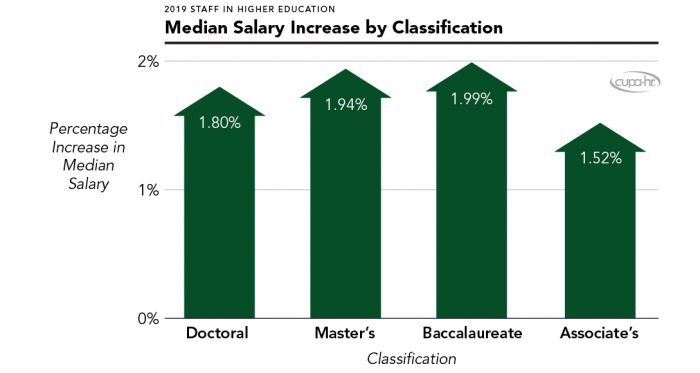The median salary increase for staff over the past year was 1.88 percent, according to CUPA-HR’s newest Staff in Higher Education Annual Report. This is a slight decline from the 1.93 percent median salary increase in 2018. The median salary increase was highest at baccalaureate institutions (1.99 percent) and lowest at associate’s institutions (1.52 percent).

The position of graphic design paraprofessional experienced the most job growth this year (26 percent increase), whereas building control systems technician saw the largest decline (24 percent decrease). Overall, the number of staff reported by higher education institutions grew minimally, only increasing by 0.4 percent from 2018 to 2019.
Other findings from the 2019 CUPA-HR Staff in Higher Education Annual Report include:
- Skilled craft lead positions were paid many of the highest staff salaries, with electrician lead making the highest median salary overall ($56,691).
- At present, 15 states and the District of Columbia have passed legislation enacting future minimum wage increases. In these places, 11 percent of higher ed staff overall currently earn below these future state minimums and may require pay increases in the next several years.
- A combined 75 percent of higher ed staff work in either office/clerical (41 percent) or service/maintenance positions (34 percent). The two most common positions are custodian/housekeeper and administrative assistant, each making up around 14 percent of the staff workforce.
- Women make up 61 percent of higher ed staff overall, and minorities make up 31 percent of staff — both figures are unchanged from last year. Women are paid less than equitably compared to men in all staff areas except for office/clerical positions. Minorities (except Asians) are paid less in the same position than are White staff across all areas.
- Salaries for higher ed staff differ considerably by state and region. Median salaries in the Northeast ($39,756) and West ($39,408) are higher than in the Midwest ($36,649) and South ($35,000).
To learn more about the Staff in Higher Education Survey, read the overview. Salaries, demographic comparisons and detailed trend information are available in the full report.
No comments:
Post a Comment